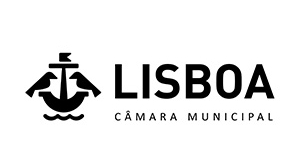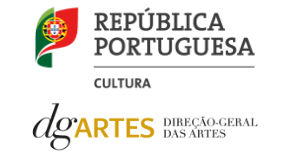 Maybe that's the secret of satire: behaving like Schrödinger's cat: for every side that wants it dead, there's an opposite side that keeps it alive. But this is just a maybe, I barely know enough about humor, let alone physics, to know if the metaphor is actually applicable.
Maybe that's the secret of satire: behaving like Schrödinger's cat: for every side that wants it dead, there's an opposite side that keeps it alive. But this is just a maybe, I barely know enough about humor, let alone physics, to know if the metaphor is actually applicable.
01.04.2025 | by Pedro Goulão
 Jasse considers how the various European colonial projects shared the similar aim, for which they competed, of access to all sorts of resources for the economic benefit of their elites – a reality that, now being propelled under new globalized guises by new (alongside the same old) agents of so-called progress and development, is far from over.
Jasse considers how the various European colonial projects shared the similar aim, for which they competed, of access to all sorts of resources for the economic benefit of their elites – a reality that, now being propelled under new globalized guises by new (alongside the same old) agents of so-called progress and development, is far from over.
25.03.2025 | by Ana Balona de Oliveira
 Despite being financially autonomous and not feeling personally discriminated against, Maria Eugénia was sensitive to the “colonial condition” inspired by her political conscience, motivating her to take action in the face of the circumstances of her time, a fact that makes her an unusual woman, not only in that specific era, but in any era that demands rejection of convention and conformism in the face of an unjust social order. Maria Eugénia was not a guerrilla fighter, nor a nurse, nor a political counselor to the nationalist movement.
Despite being financially autonomous and not feeling personally discriminated against, Maria Eugénia was sensitive to the “colonial condition” inspired by her political conscience, motivating her to take action in the face of the circumstances of her time, a fact that makes her an unusual woman, not only in that specific era, but in any era that demands rejection of convention and conformism in the face of an unjust social order. Maria Eugénia was not a guerrilla fighter, nor a nurse, nor a political counselor to the nationalist movement.
10.03.2025 | by Aida Gomes
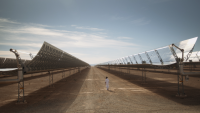 In the exhibition the sun does not rise in the north, de Miranda proposes one-person tales navigating between fictional and non-fictional narratives in the affective space of the border. The exhibition investigates the landscapes that witness hope, from the journeys of migration between Africa and Europe, set within a duality of existence and citizenship: one contemplating Europe and the other a return to Africa.
In the exhibition the sun does not rise in the north, de Miranda proposes one-person tales navigating between fictional and non-fictional narratives in the affective space of the border. The exhibition investigates the landscapes that witness hope, from the journeys of migration between Africa and Europe, set within a duality of existence and citizenship: one contemplating Europe and the other a return to Africa.
26.04.2023 | by Cindy Sissokho
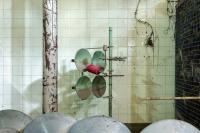 This series continues the investigations that singularise Chagas’ work, namely the attention to the experiential and affective relationships that subjects establish with everyday objects and spaces, countering fast rhythms of consumption through a decelerated gaze that closely scrutinises discarded materials, shapes and textures. However, the series simultaneously marks a kind of turning point, insofar as, unlike previous series carried out in various urban public spaces to the North and South, vaguely identified (the streets and beaches of Luanda, Venice, London and Newport, etc.), in this series, for the first time, the photographer focused on the indoors and outdoors of a specific architecture.
This series continues the investigations that singularise Chagas’ work, namely the attention to the experiential and affective relationships that subjects establish with everyday objects and spaces, countering fast rhythms of consumption through a decelerated gaze that closely scrutinises discarded materials, shapes and textures. However, the series simultaneously marks a kind of turning point, insofar as, unlike previous series carried out in various urban public spaces to the North and South, vaguely identified (the streets and beaches of Luanda, Venice, London and Newport, etc.), in this series, for the first time, the photographer focused on the indoors and outdoors of a specific architecture.
29.09.2022 | by Ana Balona de Oliveira
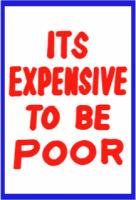 For PARLA_MUTE his latest show at Michael Janssen Gallery in Berlin, Yonamine presents a series of posters and silkscreens made from a number of phrases and graphic material picked up, once more, from the streets and transformed incessantly through the remix. We should prepare ourselves, once more, for a poignant show filled with seemingly contradictory messages—“It’s expensive to be poor” resonates strongly, or think about the title if one reads it on a bilingual horizon—in which the incessant variations of a handful of themes take centerstage, as they unfold and unfold infinitely.
For PARLA_MUTE his latest show at Michael Janssen Gallery in Berlin, Yonamine presents a series of posters and silkscreens made from a number of phrases and graphic material picked up, once more, from the streets and transformed incessantly through the remix. We should prepare ourselves, once more, for a poignant show filled with seemingly contradictory messages—“It’s expensive to be poor” resonates strongly, or think about the title if one reads it on a bilingual horizon—in which the incessant variations of a handful of themes take centerstage, as they unfold and unfold infinitely.
02.09.2022 | by Yonamine and José Luis Falconi
 In the wall text of the exhibition dedicated to African heritage “Appropriating objects and colonial fictions of Africa”, the curators state that “the current projects aim at the decolonization of collections through cooperation with partners from the societies of origin”. However, is this premise really being put into practice?
In the wall text of the exhibition dedicated to African heritage “Appropriating objects and colonial fictions of Africa”, the curators state that “the current projects aim at the decolonization of collections through cooperation with partners from the societies of origin”. However, is this premise really being put into practice?
30.03.2022 | by Ana Temudo
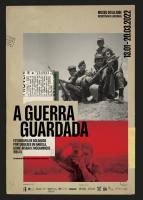 During their years at war, thousands of the young recruits sent to Angola, Guinea-Bissau and Mozambique took photos of what surrounded them: their comrades, barracks, landscapes, daily life, the civilian population, and the military apparatus. These images managed to evade the censorship of the regime, and were stored away or sent by mail as proof of their distant lives.
Some of these men built improvised darkrooms, others managed to access official ones. Many visited photography shops that flourished as a consequence of the demand generated by the war, and many bought and exchanged images. All this created the photographic archives of which we here present a part.
During their years at war, thousands of the young recruits sent to Angola, Guinea-Bissau and Mozambique took photos of what surrounded them: their comrades, barracks, landscapes, daily life, the civilian population, and the military apparatus. These images managed to evade the censorship of the regime, and were stored away or sent by mail as proof of their distant lives.
Some of these men built improvised darkrooms, others managed to access official ones. Many visited photography shops that flourished as a consequence of the demand generated by the war, and many bought and exchanged images. All this created the photographic archives of which we here present a part.
05.01.2022 | by Inês Ponte and Maria José Lobo Antunes
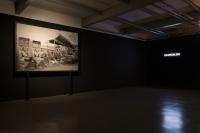 “The Mechanics of the Ephemeral” stems from the idea that art as a mechanism allows us to travel to different temporal spaces by adopting an approach that often resorts to fantasy, but in which the imagination becomes an important ally in historical and socio-political questioning. Although the discourses of the invited artists vary in their approaches and navigation of this temporal and identity- forming flow, the common denominator is their relationship with a continent inhabited by the dreams and follies of foreign ghosts. There is also an urgent need to address a future still based on meaningless promises of progress and freedom – a situation which is not exclusive to the African continent – to equally embrace the influences of the various artistic languages and references that comprise this joint work and overflow national borders and continental platforms.
“The Mechanics of the Ephemeral” stems from the idea that art as a mechanism allows us to travel to different temporal spaces by adopting an approach that often resorts to fantasy, but in which the imagination becomes an important ally in historical and socio-political questioning. Although the discourses of the invited artists vary in their approaches and navigation of this temporal and identity- forming flow, the common denominator is their relationship with a continent inhabited by the dreams and follies of foreign ghosts. There is also an urgent need to address a future still based on meaningless promises of progress and freedom – a situation which is not exclusive to the African continent – to equally embrace the influences of the various artistic languages and references that comprise this joint work and overflow national borders and continental platforms.
21.12.2021 | by Gisela Casimiro
 From the 14th of July, the website of the Tchiweka Documentation Association (ATD) is open to the public, putting online a large part of the archive that, since 2006, its Documentation Center has been managing, organizing and expanding.
From the 14th of July, the website of the Tchiweka Documentation Association (ATD) is open to the public, putting online a large part of the archive that, since 2006, its Documentation Center has been managing, organizing and expanding.
13.07.2021 | by Associação Tchiweka de Documentação
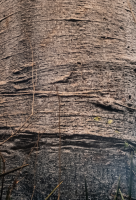 António Ole: Vital Matter gathers works from different periods of António Ole's (Luanda, 1951) multifaceted artistic journey of over fifty years. Made in various media, from sculpture to photography, from drawing to video, these works highlight the attention that Ole has devoted to nature and its vital elements and materials. The earth, water, fire and air here take on countless forms that, as a whole, invite a planetary perception and an ecological awareness not only of the cohabitation, but, above all, of the interdependence between human and non-human forms of life (animal, vegetable, mineral) – vital matter to whose urgency the pandemic itself has, more than ever, alerted us.
António Ole: Vital Matter gathers works from different periods of António Ole's (Luanda, 1951) multifaceted artistic journey of over fifty years. Made in various media, from sculpture to photography, from drawing to video, these works highlight the attention that Ole has devoted to nature and its vital elements and materials. The earth, water, fire and air here take on countless forms that, as a whole, invite a planetary perception and an ecological awareness not only of the cohabitation, but, above all, of the interdependence between human and non-human forms of life (animal, vegetable, mineral) – vital matter to whose urgency the pandemic itself has, more than ever, alerted us.
27.04.2021 | by Ana Balona de Oliveira
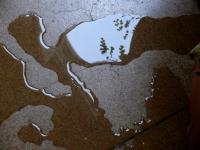 With a work markedly attentive to the rhythms and faces, the materials and constructions, the urban surfaces and textures – in particular, of Luanda, its slums or musseques and its islands –, from an early age Ole also observed that other Angola so dissimilar from the capital, its diverse landscapes and ways of life. António Ole: Vital Matter unveils, precisely, some of these other rhythms and textures, the vital matters beyond the walls and the skin of the city.
With a work markedly attentive to the rhythms and faces, the materials and constructions, the urban surfaces and textures – in particular, of Luanda, its slums or musseques and its islands –, from an early age Ole also observed that other Angola so dissimilar from the capital, its diverse landscapes and ways of life. António Ole: Vital Matter unveils, precisely, some of these other rhythms and textures, the vital matters beyond the walls and the skin of the city.
14.04.2021 | by Ana Balona de Oliveira
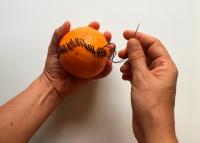 In a society still marked by profound gender inequality, and understanding emancipation and freedom as processes that are daily struggles, we debate achievements and rights, and expectations when it comes to the body, career, maternity, representation, circulation, and artistic proposals. Part of it are also sickness, birth, war, violence, sexual freedom, the domestic universe, the world of labour (and invisible labour) and our current forceful will to break with the status quo.
In a society still marked by profound gender inequality, and understanding emancipation and freedom as processes that are daily struggles, we debate achievements and rights, and expectations when it comes to the body, career, maternity, representation, circulation, and artistic proposals. Part of it are also sickness, birth, war, violence, sexual freedom, the domestic universe, the world of labour (and invisible labour) and our current forceful will to break with the status quo.
14.09.2020 | by Marta Lança
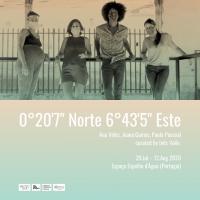 Creating a sensational dialogue between our translucent memories and the luminosities that surround the landscape of this island–art gallery, hangs in the middle of the space, a site-specific artwork created by Ana, Joana and Paulo. A work composed by two suspended raw linen cloth paintings, with more than three meters, in which one holds the coulours of the dawn and the other of the sunset, alongside a soundtrack where we hear Paulo’s voice, dyed with the sounds of the island echoing through the exhibition space, so you too can hear and see the colours of São Tomé and Príncipe.
Creating a sensational dialogue between our translucent memories and the luminosities that surround the landscape of this island–art gallery, hangs in the middle of the space, a site-specific artwork created by Ana, Joana and Paulo. A work composed by two suspended raw linen cloth paintings, with more than three meters, in which one holds the coulours of the dawn and the other of the sunset, alongside a soundtrack where we hear Paulo’s voice, dyed with the sounds of the island echoing through the exhibition space, so you too can hear and see the colours of São Tomé and Príncipe.
14.08.2020 | by Inês Valle
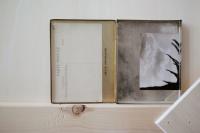 Through the territories of Brazilian northeast where he comes from and never cease to return, to the streets of São Paulo, London, Paris, Naples or a little village in Andaluzia, the artist is always moving. Not more as a traveler then exiled or immigrant, Ícaro Lira does not celebrates nomadism, but is interested in transfigurations – political, economical
and social, but also on intimate ones – brought by these circulations. Starting from his trips, which are above all meetings, he brings back objects: wood pieces, stones, pictures, trash, administrative documents, press articles, but also audio interviews and personal notes. So many traces with unique stories that, juxtaposed and on a set, became a weave of fragile meaning and open to interpretation.
Through the territories of Brazilian northeast where he comes from and never cease to return, to the streets of São Paulo, London, Paris, Naples or a little village in Andaluzia, the artist is always moving. Not more as a traveler then exiled or immigrant, Ícaro Lira does not celebrates nomadism, but is interested in transfigurations – political, economical
and social, but also on intimate ones – brought by these circulations. Starting from his trips, which are above all meetings, he brings back objects: wood pieces, stones, pictures, trash, administrative documents, press articles, but also audio interviews and personal notes. So many traces with unique stories that, juxtaposed and on a set, became a weave of fragile meaning and open to interpretation.
04.02.2020 | by Elena Lespes Muñoz
 Through the territories of Brazilian northeast where he comes from and never cease to return, to the streets of São Paulo, London, Paris, Naples or a little village in Andaluzia, the artist is always moving. Not more as a traveler then exiled or immigrant, Ícaro Lira does not celebrates nomadism, but is interested in transfigurations – political, economical
and social, but also on intimate ones – brought by these circulations. Starting from his trips, which are above all meetings, he brings back objects: wood pieces, stones, pictures, trash, administrative documents, press articles, but also audio interviews and personal notes. So many traces with unique stories that, juxtaposed and on a set, became a weave of fragile meaning and open to interpretation.
Through the territories of Brazilian northeast where he comes from and never cease to return, to the streets of São Paulo, London, Paris, Naples or a little village in Andaluzia, the artist is always moving. Not more as a traveler then exiled or immigrant, Ícaro Lira does not celebrates nomadism, but is interested in transfigurations – political, economical
and social, but also on intimate ones – brought by these circulations. Starting from his trips, which are above all meetings, he brings back objects: wood pieces, stones, pictures, trash, administrative documents, press articles, but also audio interviews and personal notes. So many traces with unique stories that, juxtaposed and on a set, became a weave of fragile meaning and open to interpretation.
04.02.2020 | by Elena Lespes Muñoz
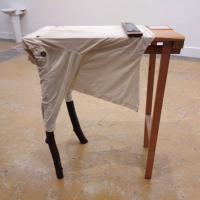 Jimmie Durham brings to the surface the issue of the truth of the artwork, probably one of the most relevant themes in a world that is constantly forgetting about the fictional nature of art – not necessarily implying that it lacks an intrinsic paradoxical truth in its materiality and representational nature.
Jimmie Durham brings to the surface the issue of the truth of the artwork, probably one of the most relevant themes in a world that is constantly forgetting about the fictional nature of art – not necessarily implying that it lacks an intrinsic paradoxical truth in its materiality and representational nature.
04.12.2019 | by Delfim Sardo
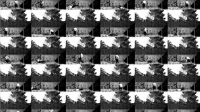 Pathological states such as ‘land disease’, ‘tired head disease’ and even ‘disease caused by the hand’ allude to the states of anxiety, instability and vulnerability suffered by these communities, but also the loss of location in relation to the cultural and geographical space occupied by the subjects. They also convey the state of intense negotiation that exists between ‘negative supernatural forces’ and unequal social and political structures, in a place halfway between the land of origin and the land of arrival.
Pathological states such as ‘land disease’, ‘tired head disease’ and even ‘disease caused by the hand’ allude to the states of anxiety, instability and vulnerability suffered by these communities, but also the loss of location in relation to the cultural and geographical space occupied by the subjects. They also convey the state of intense negotiation that exists between ‘negative supernatural forces’ and unequal social and political structures, in a place halfway between the land of origin and the land of arrival.
04.10.2019 | by Rita Fabiana
 Yonamine has theatrically composed the gallery walls with posters made out of a selection of articles from Zimbabwean newspapers, paintings and video animations, showing several graphic references of power such as Napoleon figure and the Ku Kux Klan uniform presented in a navy blue adulterated version colour that evokes the uniforms of Zimbabwe's workers. All these elements are presented as political propaganda in the eve of an election, personifying the conqueror's evil thirst to reach power and control by keeping the opposition voiceless.
Yonamine has theatrically composed the gallery walls with posters made out of a selection of articles from Zimbabwean newspapers, paintings and video animations, showing several graphic references of power such as Napoleon figure and the Ku Kux Klan uniform presented in a navy blue adulterated version colour that evokes the uniforms of Zimbabwe's workers. All these elements are presented as political propaganda in the eve of an election, personifying the conqueror's evil thirst to reach power and control by keeping the opposition voiceless.
26.08.2019 | by Cécile Bourne-Farrell
 Maybe that's the secret of satire: behaving like Schrödinger's cat: for every side that wants it dead, there's an opposite side that keeps it alive. But this is just a maybe, I barely know enough about humor, let alone physics, to know if the metaphor is actually applicable.
Maybe that's the secret of satire: behaving like Schrödinger's cat: for every side that wants it dead, there's an opposite side that keeps it alive. But this is just a maybe, I barely know enough about humor, let alone physics, to know if the metaphor is actually applicable.  Jasse considers how the various European colonial projects shared the similar aim, for which they competed, of access to all sorts of resources for the economic benefit of their elites – a reality that, now being propelled under new globalized guises by new (alongside the same old) agents of so-called progress and development, is far from over.
Jasse considers how the various European colonial projects shared the similar aim, for which they competed, of access to all sorts of resources for the economic benefit of their elites – a reality that, now being propelled under new globalized guises by new (alongside the same old) agents of so-called progress and development, is far from over.  Despite being financially autonomous and not feeling personally discriminated against, Maria Eugénia was sensitive to the “colonial condition” inspired by her political conscience, motivating her to take action in the face of the circumstances of her time, a fact that makes her an unusual woman, not only in that specific era, but in any era that demands rejection of convention and conformism in the face of an unjust social order. Maria Eugénia was not a guerrilla fighter, nor a nurse, nor a political counselor to the nationalist movement.
Despite being financially autonomous and not feeling personally discriminated against, Maria Eugénia was sensitive to the “colonial condition” inspired by her political conscience, motivating her to take action in the face of the circumstances of her time, a fact that makes her an unusual woman, not only in that specific era, but in any era that demands rejection of convention and conformism in the face of an unjust social order. Maria Eugénia was not a guerrilla fighter, nor a nurse, nor a political counselor to the nationalist movement.  In the exhibition the sun does not rise in the north, de Miranda proposes one-person tales navigating between fictional and non-fictional narratives in the affective space of the border. The exhibition investigates the landscapes that witness hope, from the journeys of migration between Africa and Europe, set within a duality of existence and citizenship: one contemplating Europe and the other a return to Africa.
In the exhibition the sun does not rise in the north, de Miranda proposes one-person tales navigating between fictional and non-fictional narratives in the affective space of the border. The exhibition investigates the landscapes that witness hope, from the journeys of migration between Africa and Europe, set within a duality of existence and citizenship: one contemplating Europe and the other a return to Africa.  This series continues the investigations that singularise Chagas’ work, namely the attention to the experiential and affective relationships that subjects establish with everyday objects and spaces, countering fast rhythms of consumption through a decelerated gaze that closely scrutinises discarded materials, shapes and textures. However, the series simultaneously marks a kind of turning point, insofar as, unlike previous series carried out in various urban public spaces to the North and South, vaguely identified (the streets and beaches of Luanda, Venice, London and Newport, etc.), in this series, for the first time, the photographer focused on the indoors and outdoors of a specific architecture.
This series continues the investigations that singularise Chagas’ work, namely the attention to the experiential and affective relationships that subjects establish with everyday objects and spaces, countering fast rhythms of consumption through a decelerated gaze that closely scrutinises discarded materials, shapes and textures. However, the series simultaneously marks a kind of turning point, insofar as, unlike previous series carried out in various urban public spaces to the North and South, vaguely identified (the streets and beaches of Luanda, Venice, London and Newport, etc.), in this series, for the first time, the photographer focused on the indoors and outdoors of a specific architecture.  For PARLA_MUTE his latest show at Michael Janssen Gallery in Berlin, Yonamine presents a series of posters and silkscreens made from a number of phrases and graphic material picked up, once more, from the streets and transformed incessantly through the remix. We should prepare ourselves, once more, for a poignant show filled with seemingly contradictory messages—“It’s expensive to be poor” resonates strongly, or think about the title if one reads it on a bilingual horizon—in which the incessant variations of a handful of themes take centerstage, as they unfold and unfold infinitely.
For PARLA_MUTE his latest show at Michael Janssen Gallery in Berlin, Yonamine presents a series of posters and silkscreens made from a number of phrases and graphic material picked up, once more, from the streets and transformed incessantly through the remix. We should prepare ourselves, once more, for a poignant show filled with seemingly contradictory messages—“It’s expensive to be poor” resonates strongly, or think about the title if one reads it on a bilingual horizon—in which the incessant variations of a handful of themes take centerstage, as they unfold and unfold infinitely.  In the wall text of the exhibition dedicated to African heritage “Appropriating objects and colonial fictions of Africa”, the curators state that “the current projects aim at the decolonization of collections through cooperation with partners from the societies of origin”. However, is this premise really being put into practice?
In the wall text of the exhibition dedicated to African heritage “Appropriating objects and colonial fictions of Africa”, the curators state that “the current projects aim at the decolonization of collections through cooperation with partners from the societies of origin”. However, is this premise really being put into practice?  During their years at war, thousands of the young recruits sent to Angola, Guinea-Bissau and Mozambique took photos of what surrounded them: their comrades, barracks, landscapes, daily life, the civilian population, and the military apparatus. These images managed to evade the censorship of the regime, and were stored away or sent by mail as proof of their distant lives.
Some of these men built improvised darkrooms, others managed to access official ones. Many visited photography shops that flourished as a consequence of the demand generated by the war, and many bought and exchanged images. All this created the photographic archives of which we here present a part.
During their years at war, thousands of the young recruits sent to Angola, Guinea-Bissau and Mozambique took photos of what surrounded them: their comrades, barracks, landscapes, daily life, the civilian population, and the military apparatus. These images managed to evade the censorship of the regime, and were stored away or sent by mail as proof of their distant lives.
Some of these men built improvised darkrooms, others managed to access official ones. Many visited photography shops that flourished as a consequence of the demand generated by the war, and many bought and exchanged images. All this created the photographic archives of which we here present a part.  “The Mechanics of the Ephemeral” stems from the idea that art as a mechanism allows us to travel to different temporal spaces by adopting an approach that often resorts to fantasy, but in which the imagination becomes an important ally in historical and socio-political questioning. Although the discourses of the invited artists vary in their approaches and navigation of this temporal and identity- forming flow, the common denominator is their relationship with a continent inhabited by the dreams and follies of foreign ghosts. There is also an urgent need to address a future still based on meaningless promises of progress and freedom – a situation which is not exclusive to the African continent – to equally embrace the influences of the various artistic languages and references that comprise this joint work and overflow national borders and continental platforms.
“The Mechanics of the Ephemeral” stems from the idea that art as a mechanism allows us to travel to different temporal spaces by adopting an approach that often resorts to fantasy, but in which the imagination becomes an important ally in historical and socio-political questioning. Although the discourses of the invited artists vary in their approaches and navigation of this temporal and identity- forming flow, the common denominator is their relationship with a continent inhabited by the dreams and follies of foreign ghosts. There is also an urgent need to address a future still based on meaningless promises of progress and freedom – a situation which is not exclusive to the African continent – to equally embrace the influences of the various artistic languages and references that comprise this joint work and overflow national borders and continental platforms.  From the 14th of July, the website of the Tchiweka Documentation Association (ATD) is open to the public, putting online a large part of the archive that, since 2006, its Documentation Center has been managing, organizing and expanding.
From the 14th of July, the website of the Tchiweka Documentation Association (ATD) is open to the public, putting online a large part of the archive that, since 2006, its Documentation Center has been managing, organizing and expanding.  António Ole: Vital Matter gathers works from different periods of António Ole's (Luanda, 1951) multifaceted artistic journey of over fifty years. Made in various media, from sculpture to photography, from drawing to video, these works highlight the attention that Ole has devoted to nature and its vital elements and materials. The earth, water, fire and air here take on countless forms that, as a whole, invite a planetary perception and an ecological awareness not only of the cohabitation, but, above all, of the interdependence between human and non-human forms of life (animal, vegetable, mineral) – vital matter to whose urgency the pandemic itself has, more than ever, alerted us.
António Ole: Vital Matter gathers works from different periods of António Ole's (Luanda, 1951) multifaceted artistic journey of over fifty years. Made in various media, from sculpture to photography, from drawing to video, these works highlight the attention that Ole has devoted to nature and its vital elements and materials. The earth, water, fire and air here take on countless forms that, as a whole, invite a planetary perception and an ecological awareness not only of the cohabitation, but, above all, of the interdependence between human and non-human forms of life (animal, vegetable, mineral) – vital matter to whose urgency the pandemic itself has, more than ever, alerted us.  With a work markedly attentive to the rhythms and faces, the materials and constructions, the urban surfaces and textures – in particular, of Luanda, its slums or musseques and its islands –, from an early age Ole also observed that other Angola so dissimilar from the capital, its diverse landscapes and ways of life. António Ole: Vital Matter unveils, precisely, some of these other rhythms and textures, the vital matters beyond the walls and the skin of the city.
With a work markedly attentive to the rhythms and faces, the materials and constructions, the urban surfaces and textures – in particular, of Luanda, its slums or musseques and its islands –, from an early age Ole also observed that other Angola so dissimilar from the capital, its diverse landscapes and ways of life. António Ole: Vital Matter unveils, precisely, some of these other rhythms and textures, the vital matters beyond the walls and the skin of the city.  In a society still marked by profound gender inequality, and understanding emancipation and freedom as processes that are daily struggles, we debate achievements and rights, and expectations when it comes to the body, career, maternity, representation, circulation, and artistic proposals. Part of it are also sickness, birth, war, violence, sexual freedom, the domestic universe, the world of labour (and invisible labour) and our current forceful will to break with the status quo.
In a society still marked by profound gender inequality, and understanding emancipation and freedom as processes that are daily struggles, we debate achievements and rights, and expectations when it comes to the body, career, maternity, representation, circulation, and artistic proposals. Part of it are also sickness, birth, war, violence, sexual freedom, the domestic universe, the world of labour (and invisible labour) and our current forceful will to break with the status quo.  Creating a sensational dialogue between our translucent memories and the luminosities that surround the landscape of this island–art gallery, hangs in the middle of the space, a site-specific artwork created by Ana, Joana and Paulo. A work composed by two suspended raw linen cloth paintings, with more than three meters, in which one holds the coulours of the dawn and the other of the sunset, alongside a soundtrack where we hear Paulo’s voice, dyed with the sounds of the island echoing through the exhibition space, so you too can hear and see the colours of São Tomé and Príncipe.
Creating a sensational dialogue between our translucent memories and the luminosities that surround the landscape of this island–art gallery, hangs in the middle of the space, a site-specific artwork created by Ana, Joana and Paulo. A work composed by two suspended raw linen cloth paintings, with more than three meters, in which one holds the coulours of the dawn and the other of the sunset, alongside a soundtrack where we hear Paulo’s voice, dyed with the sounds of the island echoing through the exhibition space, so you too can hear and see the colours of São Tomé and Príncipe.  Through the territories of Brazilian northeast where he comes from and never cease to return, to the streets of São Paulo, London, Paris, Naples or a little village in Andaluzia, the artist is always moving. Not more as a traveler then exiled or immigrant, Ícaro Lira does not celebrates nomadism, but is interested in transfigurations – political, economical
and social, but also on intimate ones – brought by these circulations. Starting from his trips, which are above all meetings, he brings back objects: wood pieces, stones, pictures, trash, administrative documents, press articles, but also audio interviews and personal notes. So many traces with unique stories that, juxtaposed and on a set, became a weave of fragile meaning and open to interpretation.
Through the territories of Brazilian northeast where he comes from and never cease to return, to the streets of São Paulo, London, Paris, Naples or a little village in Andaluzia, the artist is always moving. Not more as a traveler then exiled or immigrant, Ícaro Lira does not celebrates nomadism, but is interested in transfigurations – political, economical
and social, but also on intimate ones – brought by these circulations. Starting from his trips, which are above all meetings, he brings back objects: wood pieces, stones, pictures, trash, administrative documents, press articles, but also audio interviews and personal notes. So many traces with unique stories that, juxtaposed and on a set, became a weave of fragile meaning and open to interpretation.  Jimmie Durham brings to the surface the issue of the truth of the artwork, probably one of the most relevant themes in a world that is constantly forgetting about the fictional nature of art – not necessarily implying that it lacks an intrinsic paradoxical truth in its materiality and representational nature.
Jimmie Durham brings to the surface the issue of the truth of the artwork, probably one of the most relevant themes in a world that is constantly forgetting about the fictional nature of art – not necessarily implying that it lacks an intrinsic paradoxical truth in its materiality and representational nature.  Pathological states such as ‘land disease’, ‘tired head disease’ and even ‘disease caused by the hand’ allude to the states of anxiety, instability and vulnerability suffered by these communities, but also the loss of location in relation to the cultural and geographical space occupied by the subjects. They also convey the state of intense negotiation that exists between ‘negative supernatural forces’ and unequal social and political structures, in a place halfway between the land of origin and the land of arrival.
Pathological states such as ‘land disease’, ‘tired head disease’ and even ‘disease caused by the hand’ allude to the states of anxiety, instability and vulnerability suffered by these communities, but also the loss of location in relation to the cultural and geographical space occupied by the subjects. They also convey the state of intense negotiation that exists between ‘negative supernatural forces’ and unequal social and political structures, in a place halfway between the land of origin and the land of arrival.  Yonamine has theatrically composed the gallery walls with posters made out of a selection of articles from Zimbabwean newspapers, paintings and video animations, showing several graphic references of power such as Napoleon figure and the Ku Kux Klan uniform presented in a navy blue adulterated version colour that evokes the uniforms of Zimbabwe's workers. All these elements are presented as political propaganda in the eve of an election, personifying the conqueror's evil thirst to reach power and control by keeping the opposition voiceless.
Yonamine has theatrically composed the gallery walls with posters made out of a selection of articles from Zimbabwean newspapers, paintings and video animations, showing several graphic references of power such as Napoleon figure and the Ku Kux Klan uniform presented in a navy blue adulterated version colour that evokes the uniforms of Zimbabwe's workers. All these elements are presented as political propaganda in the eve of an election, personifying the conqueror's evil thirst to reach power and control by keeping the opposition voiceless. 